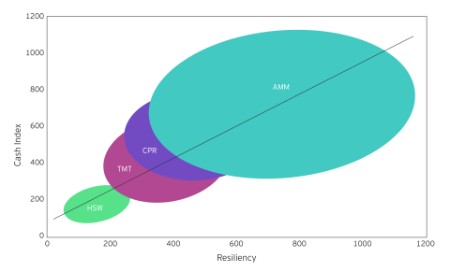Stronger cash management = better operational resilience
Companies with cash-conscious cultures and better cash management are also the most resilient.
As important a quality as resilience is, for companies, it has been a difficult thing to measure and especially difficult to achieve. Fortunately, cash management, or working capital management, is a well-understood and measurable improvement to make. Elements of net working capital are: accounts receivable, measured as days sales outstanding (DSO); accounts payable, or days payables outstanding (DPO); and inventory, or days inventory outstanding (DIO). The benefits include not only better liquidity and financial flexibility, but also operational resilience to withstand downturns.
A cash conscious culture:
- Begins at the top, with appropriate C-level messaging.
- Is embedded in policies, controls and incentives throughout the business that are focused on shortening the cash conversion cycle (CCC) to unlock cash that can be strategically reinvested.
- Enables visibility into the various operations that tie up cash.
- Embeds balance sheet accountability that emphasizes process efficiencies and other cash drivers over short-term incentives.
Companies with weaker cash management abilities are faced with a cycle of constant recovery and have, on average, 26% more quarters of below market performance than their peers, based on total shareholder return (TSR).
Companies neglect resilience for a variety of reasons.
- Typically, the focus on short-term profitability and shareholder pressure for returns can pull attention from objectives, like resilience, that don’t contribute directly to the bottom line and therefore may be seen as non-critical or only “nice to have.”
- Companies may build their strategic plans against a too-rosy forecast of stable conditions or with insufficient attention to operational realities.
- Some companies simply put resilience on a back burner because it is hard to measure, or they may regard resilience as “taken care of” because they have implemented business continuity and disaster recovery plans.

Chapter
A new way to compare cash management and resilience
We set out to shed light on how the best-run companies are creating more resilient organizations through better cash management.
We developed an approach to measure organizational resilience, using market data and metrics such as TSR, to establish an overall resiliency score, comprised of measurements in three categories of resilience—prevention, response and recovery. These align with the early, middle and late stages of a given market downturn that is experienced collectively by companies in the overall sample or industry peer group. [Figure 2]
We used this data with recognized indicators of cash management capability, such as CCC efficiency, liquidity ratios and others, to understand how high performers in cash management fare, during a market dip, against their peer group’s average performance in the three resilience measures and overall. We compared high and low cash management performers for an overall, cross-industry view, and broke down the analysis by several industrial sectors, as well. In our index, a lower score (as with CCC) indicates higher performance.

Figure 2. Source: EY-Parthenon analysis.
(For more detail on how we conducted this analysis, please see the Appendix)
-
Chart description
The graph shows a curve illustrating a typical dip and recovery in total shareholder return due to a downturn, through three phases: prevention, response and recovery.
Analysis finds working capital performers suffer less volatility in downturns
Prevention
The findings confirm our thesis that companies with better cash management are more resilient, with an average resilience score 19% better than the low performers. The logical expectation is that high performers in cash management should excel in the response and recovery stages by having cash on hand to react to a given market setback. While such companies are indeed better in these categories, a more intriguing finding is the significantly greater preventive advantage demonstrated by companies that excel in cash management. High performers in cash management led low performers by 21%, in prevention, compared with a narrower advantage of just 2% in recovery.
The lesson: while it’s undoubtedly good to have available cash during a crisis, the indirect benefits for the business of superior cash management practices are even more valuable because they help companies limit their exposure to risks in the first place.
This is because the high performer scores are measuring total business health—not only the top and bottom line, but also the balance sheet. The high performers’ leaner business operations gave them better access to credit (as seen in their 23% advantage in credit score), allowing them to experience lower volatility in downturns compared to peers.
Response
Results in the response category demonstrate that companies that are cash efficient are better able to withstand financial downturns, supply shortages and industry-specific challenges, and therefore have more options when downturns occur. This is because their comparatively strong balance sheet, again, enables them to access credit, when needed. For example, a better-managed company can borrow to invest in more inventory to meet a short-term market need, such as a supply shortage or a sudden rise or drop in demand; or a company with cash may be able to afford additional air freight for needed raw materials in an emergency.
The results also indicated that high performers are economically more efficient in the response stage of a given downturn, with higher operating cash flow (OCF) per employee than low performers, on average. These measures help explain their stronger market performance during downturns, where they remained 13% above the poorer cash performers, giving them a 14% advantage in the overall response score.
Stronger cash management performers benefit by being able to absorb business shocks without laying off workers or downsizing. Thus, they are not only more efficient when times are good, they are able to avoid painful choices during downturns.
Recovery
High cash management performers outscored low performers by 5% in the third category, recovery, due to a much stronger rebound (35%) in their operating margin score. This is an indication of the greater profitability of companies with better cash management.
Figure 3. Source: EY-Parthenon analysis.
Figure 3 demonstrates the relationship between cash management and resilience. It plots the 5,000 companies in the data sample based on their cash index and resilience scores, where lower scores indicate higher performers. The companies that are better at cash management are below the line on the chart, and these companies also tend to be grouped at the lower left corner, indicating their higher performance in both cash and resilience.

Chapter
Different industries, different impacts
Based on our client experience and analysis, cash management affects resilience in different industries. There are sector-specific considerations to keep in mind.

Figure 4. Source: EY-Parthenon analysis.
Figure 4 shows the comparative performance, against the same criteria as in Figure 3, of companies in four industry sectors that we analyzed: advanced manufacturing and mobility (AM&M); health, science and wellness (HSW); technology, media and telecommunications (TMT); and consumer products and retail (CPR). HSW, which includes hospitals, pharmaceutical and medical device companies, outperforms the other sectors due to their lower inventories, comparatively lower operating cash requirements and less exposure to consumer demand trends. Manufacturers and consumer products companies tend to perform less well overall because of their greater dependence on physical supply chains and inventory and are distributed over a wider area due to their widely varying capital requirements. The results also reflect the greater volatility of manufacturing companies and consumer products companies due to their comparative sensitivity to fluctuations in consumer demand.

Chapter
How to build resilience through a cash-conscious culture
Companies that consistently maintain healthy levels of working capital are in a position of strength when trouble strikes, compared to their peers.
These companies achieve this by adopting a two-part strategy of improving cash performance in the short term with adjustments to processes and measurable metrics, while also making the changes sustainable by building a cash culture to embed new habits and expectations throughout the organization.
Strategic, cross-functional initiatives include:
- A focus on the cash conversion cycle in addition to pricing
- Improvements to long-term cash forecasting and business planning
- Concurrent execution of high-value projects
- Measuring with KPIs
- Holding leaders accountable.
Due to the broad scope of the objectives, including the change in mindset and the reorienting of the entire organization with new management metrics, this can be difficult for companies to do themselves.
The affected functions include finance and treasury, operations, corporate functions, human resources and investor relations. Performance management and incentives need to be linked to cash objectives.
Change management efforts should include consistent messaging and training across departments to explain why cash management matters to them. Success depends on the initiative addressing the whole enterprise, sustainable improvement rather than a one-time focus, and on buy-in from the entire organization, from top management on down.
Companies have made successful cash management transformations by implementing a cash leadership office. A typical CLO is overseen by the CFO and treasurer and includes members from finance, supply chain, procurement and controller to maintain accountability within operations, inventory, accounts payable and accounts receivable.
With a CLO in place, companies can:
- Improve CFO visibility and control over cash flow
- Drive accountability through ongoing reporting
- Challenge the business to identify improvement opportunities
- Coordinate and time-phase actionable plans to optimize cash flow
- Set targets and tracking methodologies with owners and cascade into the organization.
Companies we’ve worked with to help improve their cash management practices also seem to be the most resilient companies—they are affected later, are impacted less, and recover faster—when markets turn down. Companies can establish a cash leadership office as a first step to leaping past their peers in establishing a culture of cash management, which in turn can lead to a better competitive position in times when supply chain or other disruptions hit the sector.



